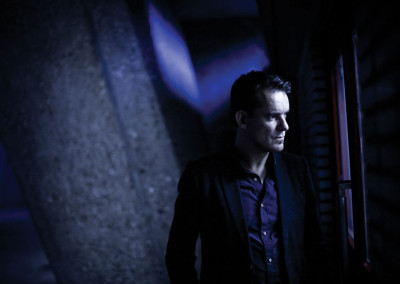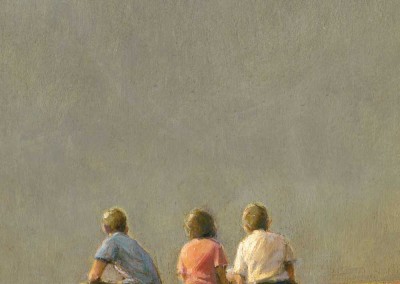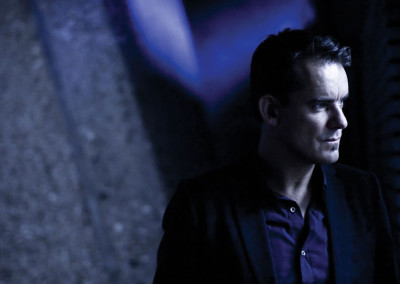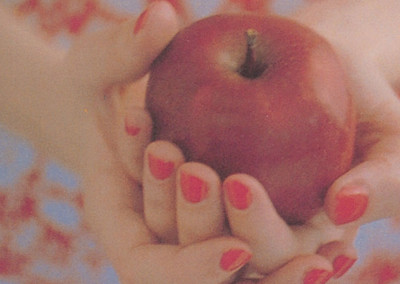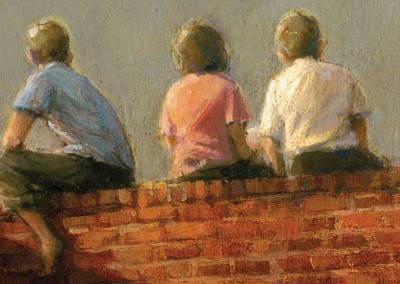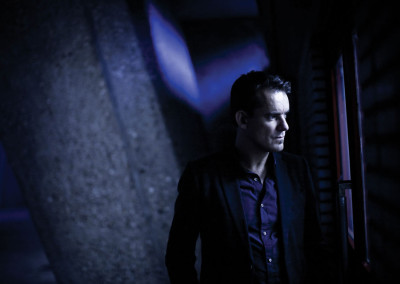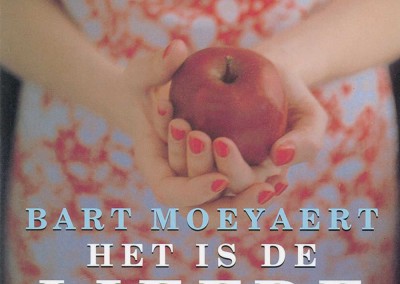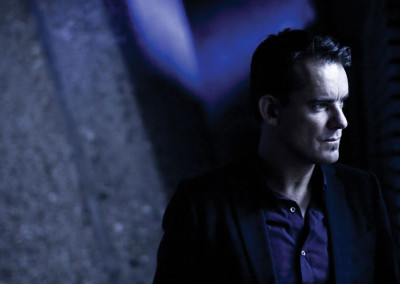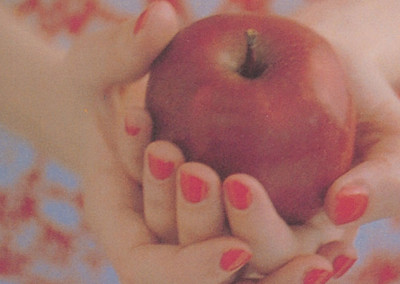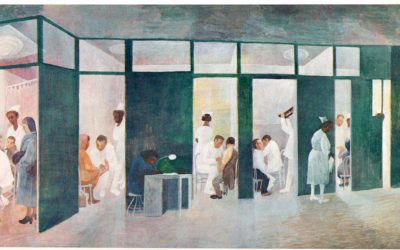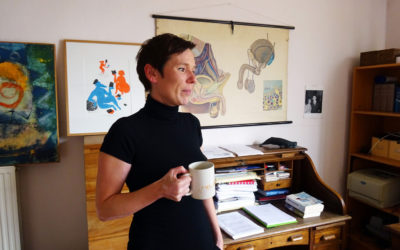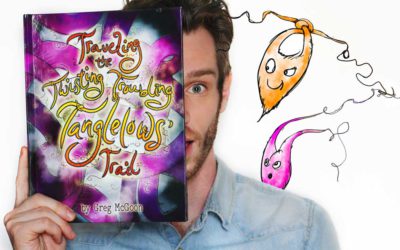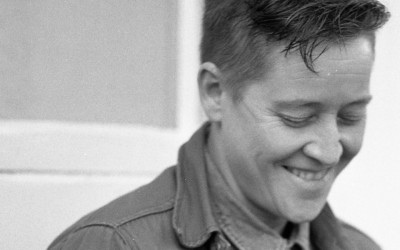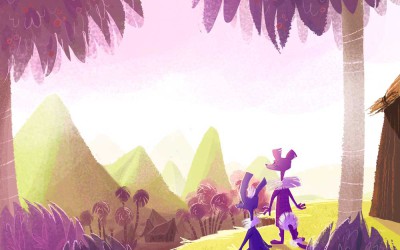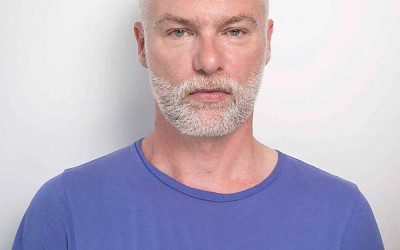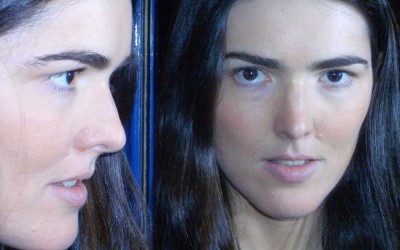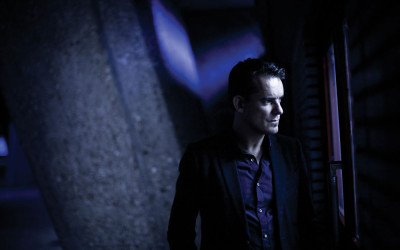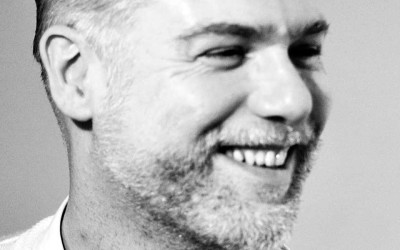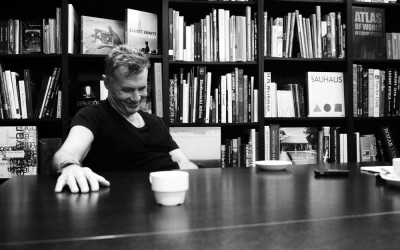In One-Man Show, Michael Schreiber chronicles the storied life, illustrious friends and lovers, and astounding adventures of Bernard Perlin through no-holds-barred interviews with the artist, candid excerpts from Perlin’s unpublished…..
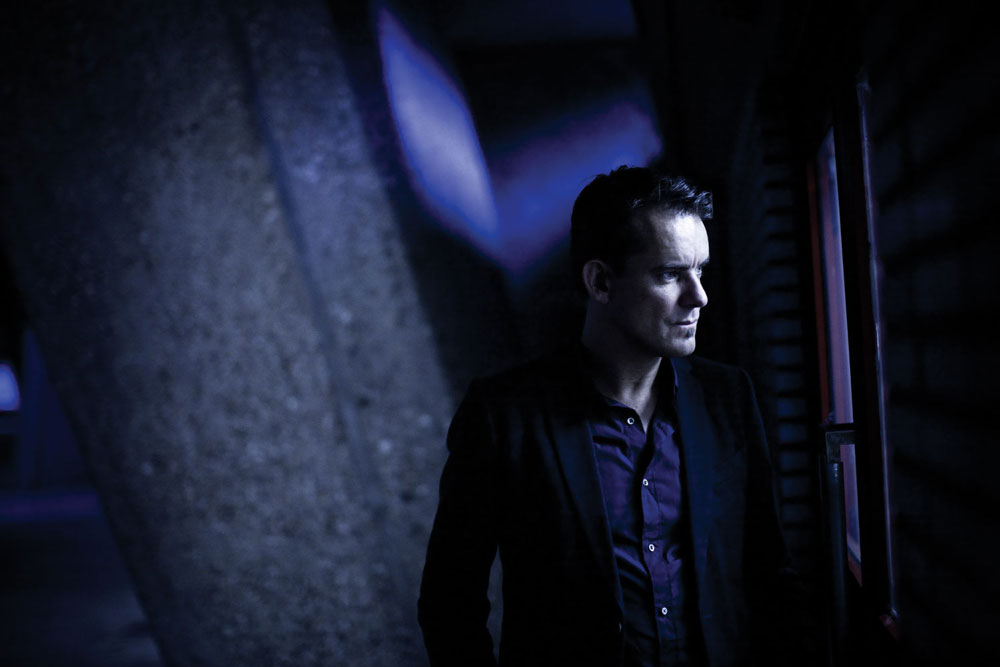
Bart Moeyaert
Bart Moeyaert
Text Nora van Craen
Bart Moeyaert is internationally famous for his work as a poet, a writer, a translator, a lecturer and a screen writer. He once mentioned on television (on ‘Reyers Late’) that society is often overwhelming, that one is alone with one’s thoughts about that, and that it is not always useful to keep on smiling all the time, pretending one is invincibly strong. I could not agree more. Hearing just one of Bart’s quotes was enough to make me realize that he has ‘a certain something’; something that makes him read between the lines of a story. That is why I was not satisfied with simply looking at his Wikipedia page to find out who he is and what he does. I wanted to experience the essence of his inner reality, a reality located in between the lines of Antwerp’s dazzling energy. So, on a sunny, yet rainy Tuesday in sunny, yet rainy May, I managed to meet him in person at the Grand Café in Antwerp. The result of that meeting was an A to Z about Bart Moeyaert, in which I will share with you some of the finest moments of our meeting, some of his unforgettable quotes and some important facts about his life.
A
Astrid Lindgren, a Swedish author best known for Pippi Longstocking, is one of the significant writers that influenced Bart. He even calls Lindgren one of his grandmothers. He cherishes Aidan Chambers’ ‘Dance on my Grave’; a comforting novel about two boys experiencing deep friendship which blossomed into love. This book inspired him to scrutinize his personality and his story telling methods. Bart lives in Antwerp. He was the official poet of this vivid city in 2006 and 2007. ‘Africa Behind the Fence’ (1995) was his first picture book for children. The illustrations were created by Anna Höglund.
B
He was born in Bruges, Belgium, on the 9th of June, 1964. As the 7th son in the family, King Baudouin by tradition became his godfather. In our conversation I mentioned the fact that the number ‘7’ regularly appears in his stories. Interestingly, this fact was new to him. “Blood, sweat and tears are fantastic, so are ugliness and shortcomings,” Bart says when it comes to the difficulties of writing. “Unfortunately, most of us are raised to think that blood, sweat and tears are to be avoided because they are unpleasant.”
C
Bart is i.a. known for his children’s books. The fact that people expect that children always get a message or a lesson from a story makes him nervous. “That is not the way one ought to deal with children. They are not adults yet, there is still plenty for them to learn, but in the meantime adults should not think about them as if they were ignorant or naïve. They can deal with a lot more than adults tend to think. Think deeply about how you were yourself when you were eight, and you will realize how you dealt with adult matters.”
D
With ‘Duet with False Notes’ Bart made his début. He was just 19 years old when he wrote this autobiographical novel. This book emerged from the diary he kept when he was 14 and 15 years old. While reading Bart’s stories, I noticed some sort of distance to the facts, of what has taken place in between two pages. Bart says he would not call this distance. Instead, he believes reality is not primarily constituted by the objective facts of the environment, but by impressions and by one’s thoughts between the lines. He escorts the reader around the covert mind of the main character of the story.
E
Together with illustrator Wolf Erlbruch and the Dutch Blazers Ensemble Bart is writing a trilogy: ‘The Creation’, ‘The Paradise’ and ‘The Heaven’. ‘The Heaven’ is to be published in 2014. In this trilogy a story meets music in a most harmonious way. Not only did he read the Bible to do a background study for ‘The Paradise’, he also made use of gardening manuals to understand why, for example, a tree loses its leaves. The story is very sensual: Eve does not resemble the biblical Eve, she has more of a ‘Lillith’ appearance.
F
Bart wants to be free: he does not want to label people or things, nor does he want his own work to be labeled. When he wrote his début, he never intended for it to be read by young people in particular. He never even thought he was going to become a children’s book author! It was his first publisher who told him an author’s image is important, his being the image of a children’s writer. It took a while before he realized he himself had to determine his writing style and path. “When I am writing a book, I might think the story will probably be read by, say, 7-year-olds, but that’s it. I only know the story I am going to tell and I have some thoughts about the shape or format.”
G
Graz (2009) is a story about Herman Eichler, a pharmacist living in Graz, Austria. One day, a young woman has an accident in front of Herman’s pharmacy. This crucial moment in Herman’s life started off a deep thought process about the man he really is. Is he a homosexual, for example? Bart wrote the largest part of this story while staying at Graz to give lectures. ‘Graz’ was written for the Antwerp theatre group ‘STAN’. Bart was nominated for Gaypersonality of 2011.
H
In 2011 Bart was nominated for the Hans Christian Andersen Award for the 4th time.
I
‘Iemands lief’ (‘Someone’s Lover’) is Bart’s version of ‘l’Histoire du Soldat’ (Stravinsky, Ramuz), written for a narrative performance with top violinist Janine Jansen. It portrays how a soldier cannot resume his normal life because the war has changed him too much. In a similar manner, Bart was so harshly transformed by being a city’s official poet that he could never return to 2005 (see M). “Feeling this sledge hammer blow made this book so much more important to me.”
J
During his stay in Japan, one of the countries where he has been giving lectures, Bart experienced an astonishing moment in a huge store: “In the middle of the computers department I felt euphoric: Japanese was written all over the place and I could not read anything of it and nobody knew my language. In my bag I carried a book which I was able to read, but the funny thing was that it was a Dutch translation of one of Coetzee’s books. This interwovenness of languages and the realization that I am constituted by languages, which I do not mind at all, made me euphorically happy.”
K
The Boekenleeuw 2013 award goes to Bart’s ‘Knock Knock, Who’s There?’ (‘Wie klopt daar?’). This is his 6th Boekenleeuw; he also won one for ‘Kiss Me’, ’Bare Hands’, ‘Its Love We Don’t Understand’, ‘The Creation’ and ‘The Milky Way’.
L
Bart is a lecturer in Creative Writing at the Royal Conservatory of Antwerp. The title of one of Bart’s books is ‘It’s Love We Don’t Understand.’ What he does understand of love is that we are raised to think that the concept of ‘man-woman-child’ and ‘house-garden-dog’ is our target, while the reality is totally different. More interesting than what he himself understands of love is the question why we decide to be with someone after that one spark, he says. Why do we make this choice so quickly, while there might be many other people in the world whom we may be compatible with? When Bart met his boyfriend, he made it clear that there are multiple loves in his life: his love for him and his love for writing. The one cannot live without the other.
‘To Bart, an artist lives multiple lives: he sees many more things from many more perspectives and tries to describe everything to himself in order to digest it.’
M
Bart married Robin Steins in 2006. During Bart’s career as the official poet of Antwerp, it was not easy for him to see eye to eye with the world and its constantly reproducing misery. He wrote a poem, ‘Woman and Child’, about the tragic racist murders by Hans Van Themsche in 2006 and read it out loud at Luna’s funeral, the murdered child. I ask him if he thinks that such a ‘blackened heart’ (‘zwartgeblakerd hart’, used in his poem ‘Lighthouse’) is useful to an artist. To Bart, an artist lives multiple lives: he sees many more things from many more perspectives and tries to describe everything to himself in order to digest it. He sees things he cannot cope with and it gets under his skin, forming that blackened heart. Through writing, a poet can digest his misery.
N
“Now is the moment in which we live. You can only finish the writings you are writing now,” Bart says to me. We were talking about how important ‘trying to be as good as possible’ was to the family he was raised in. I wanted to know how it felt to him, now that he has achieved the status of a successful writer. According to him, ‘At which mountain top would I like to arrive?’ is the most harmful, paralyzing thought to every newbie in writing. Bart did not commence his writing career thinking ‘How am I going to carve this out?’ or ‘How am I going to do this perfectly?’.New York is where he would like to be now if I were able to teleport people. Last year, he stayed there at a writer’s residence to work on his new book.
O
In 2006 he narrated the story of Olek in the musical theatre production ‘Olek Shot a Bear’ with the ‘Flemish Radio Orchestra’.
P
Together with Elisabeth Broekaert, he published ‘Let’s Stick Together’, a photo book with eight of his poems about love. In 2001 the poem ‘Small’ appeared on the side wall of the theatre house HETPALEIS (Meistraat, Antwerp). Broekaert witnessed some weddings with her camera. She took photos and watched the love that had just clinched in its own way.
Q
Most of his books were published by Querido. ‘The 27 Questions Interview’ provides you with non-trivial questions and witty facts about Bart.
R
Many meaningful concepts return in his stories and poetry. For example, he often writes about lighthouses. “In Antwerp, I find the image of a lighthouse important. It is a beacon to know there’s something over there. You can avoid it, but you can also approach it. A lighthouse says: ‘come here’. If you do not want this, then tear down the lighthouse. So if Antwerp wants to be a port city, there has to be a lighthouse. ‘Come here’: you are meant to live with it whether you like it or not.”
S
Bart decided not to have children because of the society we live in. He knows that he himself is capable of dealing with insensitive remarks about homosexuality, but one can never know if a child would be able to do the same.
T
This year he celebrates his thirtieth anniversary as a writer. Congrats, Bart! The only diary Bart isn’t fumbling with is his tumblr. Visit bartmoeyaert.tumblr.com or read his tweets at twitter.com/bartmoeyaert.
U
Many of his poems carry just one word as a title, like for example ‘Lighthouse’ and ‘Choose’. ‘U’ (‘you’) probably has the shortest title of them all.
V
Michiel Verberne was the pseudomym he used at the age of 14. When one of his poems got published in a children’s newspaper, De Stipkrant, nobody believed it was his.
W
‘Plint’, a publishing company which gives poetry a creative twist, has made a window poem of the playful rhyme ‘Once More’ (‘Weer eens’). Window poems are printed in white on transparent plastic and can be stuck to a window. On Bart’s website (www.bartmoeyaert.com) you can find a contest section posing a different question every once in a while. The winner gets one of his works for free!
X Y
“It is important to write for yourself. You should not try to please others by writing. I am not saying that you have to write as if you were the only one to read it, but you write a poem to yourself without considering person X or Y’s preferences. This implies that you allow yourself to be astonished. One has to make peace with one’s way of proceeding.”
Z
Bart lives at a stone’s throw from the Antwerp Zoo. In collaboration with the Antwerp Zoo and the city project ‘O Dierbaar Antwerpen’, the Royal Film Archive compiled a unique anthology depicting rarely seen footage of a bygone age. The first images date from the 1910s. Among others, Bart Moeyaert wrote some reflections on those images.
Related articles
Bernard Perlin
Annelies Verbeke
That’s a tough one because I don’t like to be put into a box. For me, Thirty Days is just a continuation of everything I’ve written before. I’m working on an oeuvre, which I started in 2003, and hopefully will be able to build up till the end of my days…..
Greg McGoon
Author and theatre performer Greg McGoon challenges the norm of children’s literature. By choosing a transgender princess as main character of the fairytale The Royal Heart and teaching self-acceptance in The Tanglelows, McGoon tries to…..
Ivan E. Coyote
On the day of this interview, New York passed a civil rights law that requires all single-users restrooms to be gender neutral. A decision of great impact on the daily reality of trans people and a life-changing event for Ivan E. Coyote. The award-winning…..
Square Zair Pair
Square Zair Pair is an LGBT themed children’s book about celebrating the diversity of couples in a community. The story takes place in the magical land of Hanamandoo, a place where square and round Zairs live. Zairs do all things in pairs, one…..
Ghosting. A novel by Jonathan Kemp
When 64-year-old Grace Wellbeck thinks she sees the ghost of her first husband, she fears for her sanity and worries that she’s having another breakdown. Long-buried memories come back thick and fast: from the fairground thrills of 1950s Blackpool…..
Leaving Normal
Leaving Normal: Adventures in Gender is creative nonfiction that takes an unflinching but humorous look at living as a butch woman in a pink/blue, boy-girl, M/F world. A perfect read for anyone who has ever felt different, especially those who…..
Amanda Filipacchi
I was 20 when I read Nude Men and I instantly got hooked on the surreal imagination of this New York based writer. 21 years and 3 novels later there is The Unfortunate Importance of Beauty, and Filipacchi hasn’t lost an inch of her wit and dreamlike tale…..
Gay & Night
Gay&Night Magazine started off in 1997 as a one-time special during Amsterdam Gay Pride. It soon however became so popular that it evolved into a monthly glossy. Distributed for free at almost all gay meeting spots in Belgium and The…..
Bart Moeyaert
Bart Moeyaert is internationally famous for his work as a poet, a writer, a translator, a lecturer and a screen writer. He once mentioned on television (on ‘Reyers Late’) that society is often overwhelming, that one is alone with one’s thoughts about…..
Jonathan Kemp
Jonathan Kemp won two awards and was shortlisted twice for his debut London Triptych. Gay bookstore Het Verschil in Antwerp, asked to interview the British author for a live audience due to the Dutch translation of his novel, ‘Olie op doek’. A…..
Michael Cunningham
We meet Michael Cunningham in Brussels where he is invited as an Artist in Residence by literary organisation Het Beschrijf. Coffee, Belgian chocolates and a conversation with the Pulitzer Prize-winning author of The Hours……
